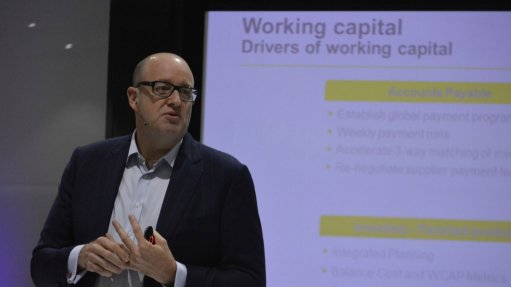
PAUL MITCHELL Extracting greater value from existing assets can drive productivity and help mining and metals companies manage risk
JOHANNESBURG (miningweekly.com) – Mining companies must move faster to generate cash and strengthen their balance sheets to ensure they can successfully navigate ongoing volatility, a report by EY has shown.
The report, ‘Navigating volatility: do you change your business or the way your business works?’, identified six key areas – labelled by EY global mining & metals advisory leader Paul Mitchell as “levers” – that mining and metals companies should focus on to strengthen their businesses and manage ongoing volatility.
These levers were cost reduction, working capital, productivity, capital effectiveness, portfolio strategy and financing.
The report was released globally on July 6 and in South Africa on July 15.
Mitchell said volatility was set to remain a challenge for the mining and metals industry for the foreseeable future. Although Mitchell averred that it was both his and EY’s perception that the mining industry downturn had bottomed out, he expected the industry to “bounce along that level for some time . . . experiencing significant volatility”.
Mitchell added that the UK’s referendum to exit the European Union had also exacerbated short-term uncertainty and, although the impact on mining would be less than other sectors, prices for industrial metals, like copper and zinc, had also fallen in the wake of the referendum result. Gold was, however, rallying as a safe haven asset.
Mining and metals companies seeking to maintain a strong balance sheet and develop plans for long-term profitability had to adopt a different mind-set to manage volatility, stated Mitchell.
“Too many have viewed cost reduction measures and productivity initiatives as a one-off, when what they need to do is embed continuous improvement in their DNA. They need to challenge themselves to find the next 10% to 20% of productivity savings.”
EY Africa mining and metals sector leader Wickus Botha added that there were, however, still a number of opportunities to remove costs.
“The success of sustainable cost reduction measures requires a shift in current business models developed during the mining boom,” he said, adding that, “We have already observed some miners being more inventive in their approach to cost reduction, including areas such as general expenses and procurement.”
Despite some improvements across the sector, the report noted that working capital was another area that remained ripe for improvement, with aggregate levels in the sector of more than $200-billion.
The report pointed to processes and systems across the supply chain as the biggest area for miners to make gains. Mitchell said mining companies needed to recognise that managing cash to improve the balance sheet was critical.
“Companies already focused on this area have achieved improvements of 30% or more. That translates into big dollar amounts for the larger players.”
For junior miners, Botha noted, the focus of cost reduction to ensure stronger balance sheets was even more critical to survive in a distressed environment. Releasing cash from working capital would require cultural change and better use of data analytics. Both areas also had a critical role to play in improving productivity, particularly when obvious opportunities across operations had already been addressed.
Meanwhile, he said that, as the mining industry moved to innovate, many solutions or approaches could be yielded from collaborating with adjacent industries.
“Extracting greater value from existing assets can drive productivity and help mining and metals companies manage risk in today’s cost-constrained market. We know that the generous commodity price conditions of the past won’t soon return to the industry,” concluded Mitchell.